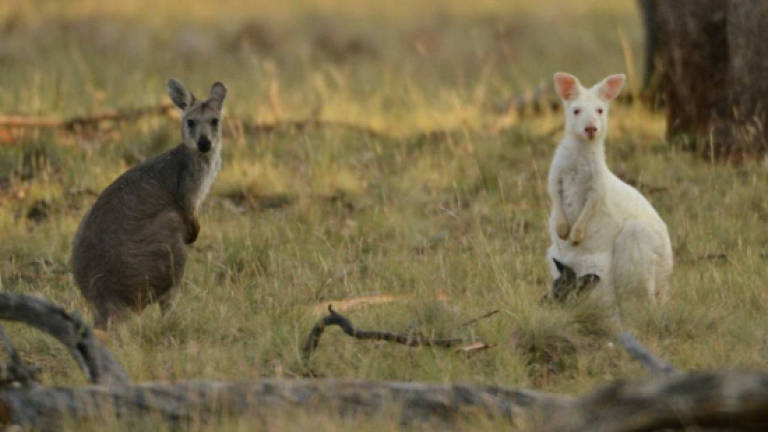Rare albino wallaroos call Aussie race track home

"THERE she is, there she is!" In the distance beyond the outstretched finger of conservation biologist Daniel Ramp stood a rare white animal, rising slowly as her ears stiffened and eyes focused on him.
Nestled below her snowy chest was a brown joey, its head peaking out of a pouch.
The 1.5-metre (4.9-feet) tall albino wallaroo bounded towards the thin trunks of eucalyptus gum trees in the Mount Panorama Woodlands, her light leaps barely breaking the silence of the natural reserve.
Several hundred metres away, the harsh sounds of revving engines echoed as V8 supercars raced around the track of Australia's spiritual home of motor sport in Bathurst, some 300 kilometres (185 miles) west of Sydney.
The white marsupial, believed to be more than four years old and one of only three spotted in the area, has thrilled researchers studying the local kangaroo population – but there are concerns about the wallaroos' chosen home in the woodlands surrounding the race circuit.
The Bathurst Kangaroo Project, funded by the University of Technology Sydney's Centre for Compassionate Conservation and Bathurst's local council, is keen to reduce the conflict between the animals and race cars.
Mount Panorama is home to the "Bathurst 1000", known as the "Great Race", which takes place in October.
The culling of some 140 kangaroos near the tracks sparked outrage in 2009, while videos of them bounding between cars travelling at almost 200 kilometres (125 miles) per hour have gone viral on YouTube.
Organisers have sought to keep them away by erecting fences but some still get on the track, causing near-misses or crashes.
"We see kangaroos jumping into fences left, right and centre, getting scared," Ramp said, describing how some kangaroos react when stressed by the race and the appearance of thousands of fans.
Unique population
Kangaroos feature on Australia's coat of arms alongside the native emu and are a mix of red, brown and grey colours, with tens of millions across Australia and more than 50 different species.
Wallaroos are slightly smaller, and typically have grey fur.
There have only been a handful of mentions of albino kangaroos in scientific literature and in the media, although zoos have bred them in the past as attractions, said Ramp from UTS.
"This population is unique and we can show very clearly the effects of that albinism," Ramp, who heads up the Bathurst Kangaroo Project, told AFP.
"The albinism is a tip of the iceberg. That's one very visual form of the recessive inbreeding that is occurring... reflective of an inbred population that is closed and has nowhere to go."
The researchers believe the three white wallaroos – two adult females and a joey – in the area may be descendents from a male albino brought to Bathurst by Australian philanthropist Sir Edward Hallstrom four decades ago.
Hallstrom – who was a trustee of Sydney's Taronga Zoo – donated the wallaroo to a local nature park, although it is not known where he got it from, the park's manager for some 25 years Ian McArtney said.
"The time that I was there, he was the main breeding male, but at no time... did he produce any albino offspring," he added.
But years later, the researchers say recessive genes carried by subsequent generations may have led to the striking creatures' re-emergence.
McArtney said he also saw albinism in smaller-sized red-neck wallabies, but none of them survived for more than a few months as they were preyed on by feral cats and foxes.
Roo-race tensions
Potential solutions to the conflict between the race and wallaroos include moving those trapped in woodlands within the circuit to another area, or changing the fences, kangaroo scientist Ray Mjadwesch said.
As part of the project, Mjadwesch dons a camouflage suit and shoots the roos with tranquilliser darts, tagging them to monitor their movements.
Listening posts pick up the frequencies emitted by tags every 30 seconds, with the figures painting a picture of where they roam on race days and for the rest of the year.
Twenty kangaroos have been tagged since the project started in May, and Ramp hopes to eventually keep tabs on 10 percent of the population, estimated to be up to 600.
Motion-sensor camera traps document the animals' behaviour, and there are plans to make the data publicly available to get the local community involved.
Ramp and his team are also collecting roo hair samples with the goal of testing their stress levels, after a recent study of wolves in Canada was able to do that using the animals' fur.
The researchers plan to count all the resident kangaroos, including the number of males, females and joeys, to identity the different family groups and how they interact.
Ultimately, they hope to document the pace at which the population is growing and expand their data-collection to other regions, amid conflicting evidence on whether the native creature is in historical decline or at plague proportions.
Four species – swamp wallabies, red-necked wallabies, wallaroos and eastern grey kangaroos – have so far been observed at Mount Panorama. – AFP